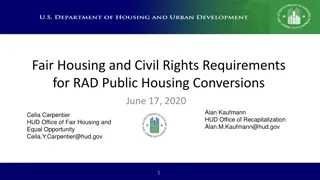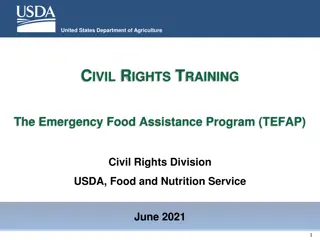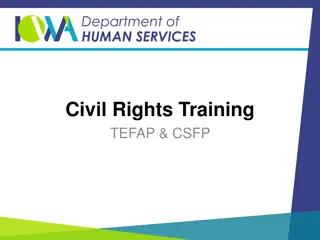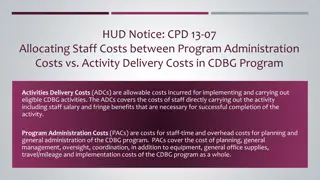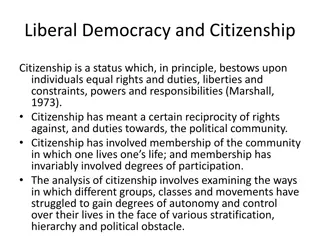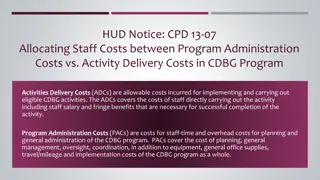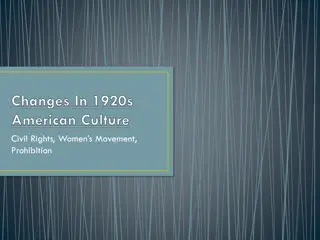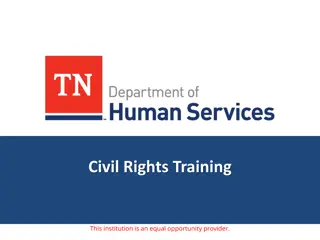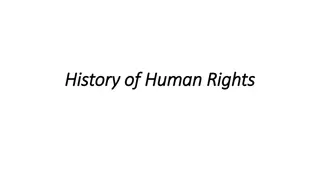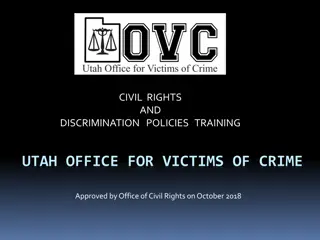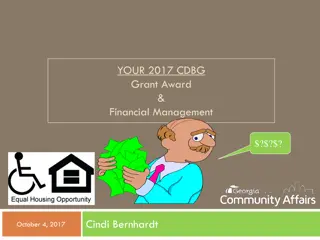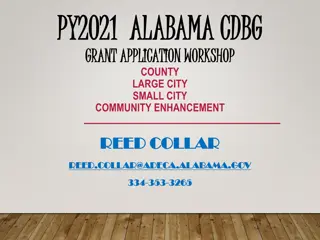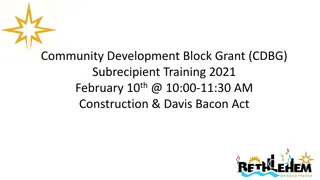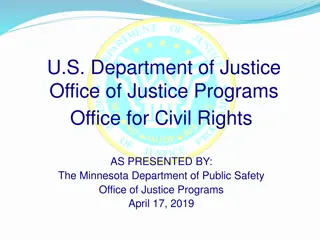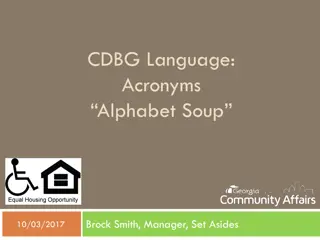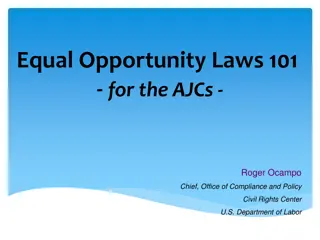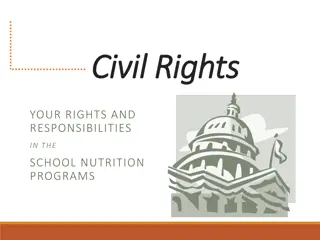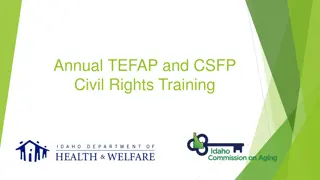
Civil Rights Compliance and Equal Opportunity in Community Development
Explore the comprehensive guide on civil rights compliance, equal employment opportunities, and fair housing regulations in community development programs. Learn about the applicable laws, minimum requirements, ensuring equal opportunity, non-discrimination policies, and tools to assist grant recipients.
Download Presentation

Please find below an Image/Link to download the presentation.
The content on the website is provided AS IS for your information and personal use only. It may not be sold, licensed, or shared on other websites without obtaining consent from the author. If you encounter any issues during the download, it is possible that the publisher has removed the file from their server.
You are allowed to download the files provided on this website for personal or commercial use, subject to the condition that they are used lawfully. All files are the property of their respective owners.
The content on the website is provided AS IS for your information and personal use only. It may not be sold, licensed, or shared on other websites without obtaining consent from the author.
E N D
Presentation Transcript
APPLICABLE LAWS TO EEO Civil Rights Act of 1964 Title VI Rehabilitation Act of 1964 Section 504 Housing and Community Development Act of 1974 Section 109 Americans with Disabilities Act of 1990 Architectural Barriers Act of 1968 Age Discrimination Act of 1975
MINIMUM REQUIREMENTS FOR CIVIL RIGHTS COMPLIANCE EQUAL EMPLOYMENT OPPORTUNITY EQUAL ACCESS TO CDBG CONTRACTS AND BUSINESS OPPORTUNITIES (CONTRACTING) SECTION 504 DISABILITY ACT REQUIREMENTS AND COMPLIANCE WITH FEDERAL FAIR HOUSING LEGISLATION
ENSURING EQUAL OPPORTUNITY Subgrantees must take measures to: Ensure non-discriminatory treatment and equal access Affirmatively Further Fair Housing Provide economic opportunities to low-income residents (Section 3)
NON-DISCRIMINATION: CDBG SUBGRANTEES MUST ADMINISTER THEIR PROGRAMS IN A NON- DISCRIMINATORY MANNER WITHOUT REGARD TO: National Origin Race Color Sex Familial Status Age Religion Disability
AFFIRMATIVELY FURTHERING FAIR HOUSING STRIVING TOWARD EQUAL HOUSING OPPORTUNITIES FOR ALL PERSONS LIVING IN YOUR JURISDICTION BY: ADMINISTERING LAWS THAT PROHIBIT DISCRIMINATION IN HOUSING PROMOTING PUBLIC AWARENESS OF FAIR HOUSING LAWS IMPROVING THE ACCESSIBILITY OF HOUSING TO PERSONS WITH DISABILITIES
FOUR SPECIFIC TOOLS TO ASSIST CDBG GRANT RECIPIENTS: ANALYSIS OF IMPEDIMENTS (AI) LCC PHASE FAIR HOUSING, EQUAL OPPORTUNITY, AND CIVIL RIGHTS COMPLIANCE QUESTIONNAIRE LCC PHASE EQUAL EMPLOYMENT OPPORTUNITY CHECKLIST MONITORING PHASE CDBG CLOSEOUT CHECKLIST CLOSEOUT PHASE
CITIZEN PARTICIPATION PLAN Essential element of the locality s community development process Encourages the input and participation of its citizens
CITIZEN PARTICIPATION PLAN Alabama requires all local government subgrantees to have a written local CPP in place ADECA s website has a template. https://adeca.alabama.gov/compliance-plans/ https://adeca.alabama.gov/compliance-plans/ CPP must be followed during both the planning and implementation phases of the CDBG project and at closeout.
GOAL OF THE CPP: TO PROVIDE ALL CITIZENS OF THE COMMUNITY WITH AN ADEQUATE OPPORTUNITY TO PARTICIPATE IN AN ADVISORY ROLE OF THE PLANNING, IMPLEMENTATION, ASSESSMENT, AND CLOSEOUT OF COMMUNITY DEVELOPMENT ACTIVITIES. CITIZEN PARTICIPATION PLAN
CITIZEN PARTICIPATION PLAN CPP places special emphasis on encouraging participation by: Persons of low-and moderate-income Residents of blighted neighborhoods Residents of areas where community development funds are utilized
CITIZEN PARTICIPATION PLAN Public participation is facilitated through public hearings in order to: Provide citizens an opportunity to comment on the applicant s community development performance Obtain views of citizens
MUST BE ADVERTISED IN A MAJOR NEWSPAPER OF GENERAL CIRCULATION. REQUIREMENTS OF PUBLIC HEARINGS: MUST BE HELD AT TIMES AND IN PLACES ACCESSIBLE TO LOW-AND MODERATE-INCOME RESIDENTS. ALL MATERIALS AND MEETINGS MUST BE ACCESSIBLE TO PERSONS WITH LIMITED ENGLISH PROFICIENCY OR SPECIAL NEEDS UPON REQUEST.
At least 1 public hearing shall be held during any CDBG program year prior to the submission of an application to ADECA. REQUIREMENTS OF PUBLIC HEARINGS: The location of all public hearings shall be accessible to persons with Disabilities. The community shall provide a sign language interpreter whenever the community is notified in advance that hearing impaired persons will be in attendance.
LANGUAGE ACCESS PLAN PRIOR TO ADVERTISING FOR OR CONDUCTING A PUBLIC HEARING, ALL SUBGRANTEES MUST CONDUCT A FOUR-FACTOR ANALYSIS AND, IF APPLICABLE, DEVELOP A LANGUAGE ACCESS PLAN FOR PERSONS WITH LIMITED ENGLISH PROFICIENCY (LEP). HTTPS://ADECA.ALABAMA.GOV/COMPLIANCE-PLANS/
LANGUAGE ACCESS PLAN IF THE FOUR-FACTOR ANALYSIS IDENTIFIES A GROUP OF LEP PERSONS, THE NOTICES AND CITIZEN PARTICIPATION MATERIALS MUST BE MADE ACCESSIBLE TO THESE INDIVIDUALS. THIS CAN INCLUDE PROVIDING AN INTERPRETER, WHEN NEEDED, AND PROVIDING MATERIALS IN THE APPROPRIATE LANGUAGE FORMAT.
SECTION 3 SECTION 3 IS A PROVISION OF THE HUD ACT OF 1968 THAT IS INTENDED TO FOSTER LOCAL ECONOMIC DEVELOPMENT, NEIGHBORHOOD ECONOMIC IMPROVEMENT, AND INDIVIDUAL SELF-SUFFICIENCY.
QUESTIONS ? Presented by Evelyn Terry ADECA CDBG 334-353-5360 Evelyn.Terry@adeca.alabama.gov Evelyn.Terry@adeca.alabama.gov

